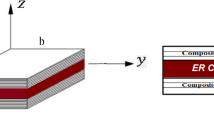Abstract
This paper investigates the dynamic characteristics of a sandwich plate embedded with an electrorheological (ER) fluid. A laser holographic interference experiment and modal testing were conducted to identify natural frequencies, modal damping and shapes of the composite structure, under different electric fields applied to the fluid domain. Moreover, the influence of the ER effect on the structural dynamic responses were recorded. It was found that both of the damping and natural frequencies of the sandwich plate increase monotonously with an increasing electric field; while, at the same time, the resonant peaks of the frequency response and the amplitudes of dynamic responses decrease. Furthermore, based on the special properties of the ER fluid, a discrete dynamic model of the sandwich plate containing ER fluids was developed and validated. The numerical simulation verifies the effect of the ER material on the structure, and the calculated dynamic parameters show the coincident changes with the experimental results.
Similar content being viewed by others
References
Vinson JR (1999) Behavior of sandwich structures of isotropic and composite materials. Technomic Publishing Company, Lancaster
Vinson JR, Chou TW (1975) Composite materials and their use in Structures. Wiley, New York
Yalcintas M, Coulter JP (1995) Electrorheological material based adaptive beams subjected to various boundary conditions. J Intell Mater Syst Structures 6:700–717
Don DL, Coulter JP (1995) An analytical and experimental investigation of electrorheological material based adaptive beam structures. J Intell Mater Syst Structures 6:846–853
Yalcintas M, Coulter JP (1995) An adaptive beam model with electrorheological material based applications, J Intell Mater Syst Structures 6:498–507
Yalcintas M, Coulter JP (1995) Analytical modeling of electrorheological material based adaptive beams. J Intell Mater Syst Structures 6:488–487
Shiang AH, Coulter JP (1996) A comparative study of AC and DC electric rheological material base adaptive structures in small amplitude vibration. J Intell Mater Syst Structures 7:455–469
Yalcintas M, Coulter JP (1998) Electrorheological material based non-homogeneous adaptive beams. Smart Mater Structures 7:128–143
Oyadiji SO (1996) Applications of electro-rheological fluids for constrained layer damping treatment of structures. J Intell Mater Syst Structures 7:541–549
HaiQing G, King LM (1997) Vibration characteristics of sandwich beams partially and fully treated with electro-rheological fluid. J Intell Mater Syst Structures 8:401–413
Choi SB, Park YK, Cheong CC (1996) Active vibration control of intelligent composite laminate structures incorporating an electro-rheological fluid. J Intell Mater Syst Structures 7:411–419
Choi SB, Park YK, Jung SB (1999) Modal characteristics of a flexible smart plate filled with electrorheological fluids. J Aircraft 36(2):458–464
Gamato DR, Filisko FE (1991) Dynamic mechanical studies of electri-rheological materials: moderate frequency. J Rheology 35(3):399–425
Ma BA, He JF (1992) A finite element analysis of viscoelastically damped sandwich plates. J Sound Vibr 152(1):107–123
Sprecher AF, Carlson JD, Conrad H (1987) Electrorheology at small strains and strain rates of suspensions of silica particles in silicon oil. Mater Sci Eng 95:187–197
Author information
Authors and Affiliations
Corresponding author
Rights and permissions
About this article
Cite this article
Lu, H., Meng, G. An experimental and analytical investigation of the dynamic characteristics of a flexible sandwich plate filled with electrorheological fluid. Int J Adv Manuf Technol 28, 1049–1055 (2006). https://doi.org/10.1007/s00170-004-2433-8
Received:
Accepted:
Published:
Issue Date:
DOI: https://doi.org/10.1007/s00170-004-2433-8



